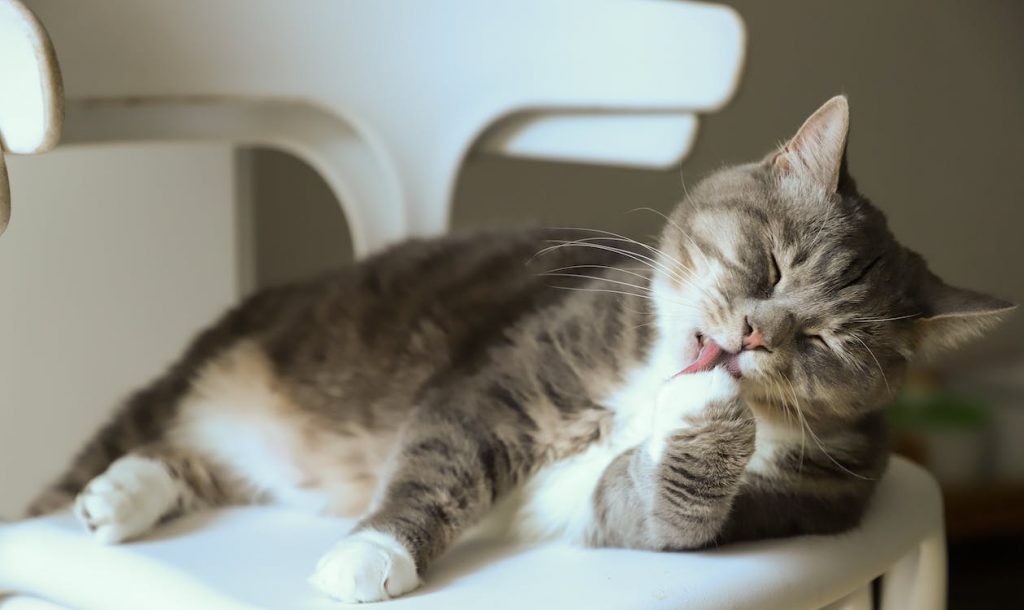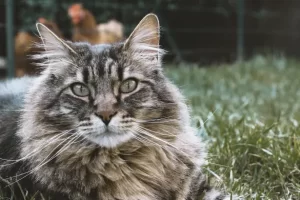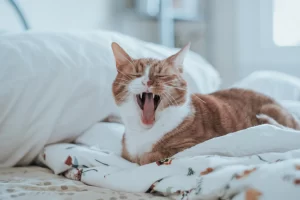Last updated on February 18th, 2023 at 06:49 pm

Have you noticed your cat plucking its hair out? Are they already balding from too much grooming? If that’s the case, your cat may suffer from Psychogenic Alopecia. Psychogenic Alopecia in cats might be one of the most problematic feline conditions you will encounter. This condition forces your cat to groom excessively, causing hair to fall out and even hurt your cat’s skin. But what causes it? And what really is Psychogenic Alopecia in cats? Is it treatable?
Don’t worry. Like OCD in cats, Psychogenic Alopecia can be managed and treated at some point. However, it’s essential to know that behavior problems may seem like Psychogenic Alopecia. You need help from a vet and cat behaviorist to diagnose if your cat has Psychogenic Alopecia. In this article, we will discuss possible symptoms and treatments you can do to help a cat with Psychogenic Alopecia. It will be a challenging ride for you, but we are here to help you manage this situation with your cat. Without further ado, let’s start!
What Is Psychogenic Alopecia In Cats?
Psychogenic alopecia is a type of hair loss in cats that is caused by psychological or emotional stress. It is most commonly seen in cats that have experienced a traumatic event or a major change in their environment.
One of the apparent symptoms of Psychogenic Alopecia is when your cat starts to get bald. However, hair loss can be a symptom of many things in cats. To put it simply, not all hair loss can be Psychogenic Alopecia. The reason cats are developing hair loss will help you and your vet determine if it is Psychogenic Alopecia.
For example, your cat may be grooming or scratching a lot because of an allergic reaction, worms, or medical illness. If this is the case, then it might not be Psychogenic Alopecia. Your cat may just be reacting to its environment or medical condition. In Psychogenic Alopecia, your cat scratches and grooms for psychological reasons. They scratch because their mind tells them to scratch. With that saying, it is considered a compulsive disorder. We all know that cats love to clean themselves, but when it is because of obsessive behavior, it will cause hair to fall off. The balding effect of Psychogenic Alopecia is usually localized because cats can easily access certain areas of their bodies. You’ll know more about it under the symptoms part of this article.
If you don’t take the precaution and steps to help your cat manage Psychogenic Alopecia, your cat may encounter skin diseases and continuous hair loss. Psychogenic Alopecia usually starts when a cat experiences stressful situations. The grooming is their diversion, and they will do it till the stress is gone. Stress and grooming might not be connected to each other regarding cat behavior. Still, with Psychogenic Alopecia, they can be one big problem for you and your feline companion.
Symptoms
As we said earlier in this article, a lot of people usually confuse Psychogenic Alopecia with a lot of medical conditions that are connected with Hair Loss. That’s why we recommended consulting a cat behaviorist or a veterinarian for further diagnosis. Here are some of the symptoms that you should look out for.
- Over-grooming, which may result in bald spots and scabs on the skin, unkempt, thinning fur.
- Excessive grooming, licking, or scratching in the areas of hair loss.
- Anxiety, such as increased vocalizing, pacing, or hiding.
- Cats who over-groom may vomit out hair in clumps as they groom themselves. These hair heaps are occasionally discovered in the homes of cats suffering from psychogenic alopecia.
- In most cases, the skin in balding places appears normal and healthy. But, this obsessive grooming and licking can cause many problems, such as claw marks and painful scratches. This causes skin redness, rashes, or scabs.
- A decrease in appetite, or refusal to eat.
- A change in behavior, such as avoiding contact or being more reclusive. . Increased aggression towards other cats or people.
- Urinating or defecating outside the litter box.
Although psychogenic alopecia in cats can cause significant skin diseases, it is crucial to highlight that this is rare. Like any other psychological problem, our feline friends can live with it. Sure, it does affect how they live their life, but with our guidance, our cats can live full lives despite having Psychogenic Alopecia.
Risk Factors
- The fundamental source of the syndrome, as the name implies, is a psychological proclivity for over-grooming. The syndrome’s psychological base is said to be similar to obsessive-compulsive disorder in humans.
- A severe aversion to fleas may cause excessive grooming in some cats.
- Stress, worry, or boredom can all cause excessive grooming and worsen psychogenic alopecia.
- Skin allergies to food, pollen, or environmental allergens could all have a role in the illness.
What Causes Psychogenic Alopecia In Cats?
After carefully explaining Psychogenic Alopecia, I’m sure you are also curious about what causes it. Here are some common causes of Psychogenic Alopecia in cats and a brief explanation of how they result in this obsessive behavior.
1. Your Cat Might Be Experiencing Stress and Anxiety
Even though cats are aloof animals, they tend to miss playing with their owners from time to time. When a cat has left alone all the time, our cats tend to experience stress and boredom, which leads them to do things to divert what they are experiencing. Some behaviors include scratching the furniture, destroying things, or harming themselves.
To avoid stressful situations for our pets, we must take extra actions such as frequent grooming, playtime, and some massage. The simple things you can do for your pet can make a huge difference. You can also purchase toys that can help ease their boredom, it can also help to induce exercise and healthy lifestyle for your pets.
2. Stereotypes Caused by Obsessive Disorders
Animal stereotypes are any form of repetitive activity that serves no function. Like the first one we mentioned, this is usually caused by stress and boredom. Cats love to have routine habits, so anything that can disrupt those habits can cause excessive stress to your cat. A few examples are when you move to a new home, add a new cat or other pets, and suddenly change your behavior towards them.
Remember to avoid giving stress to your cat. Like people, some of them can’t handle excessive stress. It may result in repetitive activities that can cause harm to you, your cat, and your furniture. Avoid making sudden changes that will disrupt your cat’s regular routine.
3. Inadequate Socialization
One of the most common mistakes cat owners make is taking kittens away from their mothers when they are young. Mother cats are the ones who should teach socialization to their young. During this stage, cats will learn skills and habits that will help them to socialize with people and other animals.
As we mentioned above, cats can quickly get stressed when introduced to new habits like trying to get along with new owners or being forced to socialize. If they are taken away early from their mothers, their mothers won’t have the chance to teach them about socialization, thus confusing them when they are forced to do it.
Cats must spend a few months with their moms and siblings before they go out and be on their own. That’s how nature works, and that is how it is supposed to be. The stress and trauma they will get from inadequate socialization can cause Psychogenic Alopecia and other psychological behavior.
4. Factors of Genetic Origin
Psychogenic Alopecia can also be genetic. I know this might confuse some cat owners, but some cat breeds are more prone to Psychogenic Alopecia. A few variables, such as oriental cat breeds and female cats, are more prone to stress and overgrooming than other cats. If you own some oriental breeds of cats or female cats, keep them away from the stress that may trigger their overgrooming habits.
5. Ringworm
Another common cause of hair loss, particularly in kittens, is ringworm (a fungal infection). This fungus causes hair loss by damaging the hair and hair follicles. Ringworm can be itchy, causing cats to lick, chew, and scratch the affected area. This results in hairless areas.
6. Physical Reasons
This might cause some confusion, especially when we say Alopecia is mainly psychological. However, a few physical factors can also trigger too much scratching for your cat. A few examples include some environmental factors such as flea bites and allergies. Animals can also behave like how people behave. For example, if a mosquito bites you and you feel that itch, you won’t stop scratching it, right? Even if it is bleeding, our brains will still tell us to scratch and scratch, not minding the pain we are experiencing.
It’s the same explanation of how physical reasons can actually affect our minds and what we do. Cats love scratching themselves and a few things, but some cats are just psychologically motivated to do it more than usual cats. It is highly typical for cats to be allergic to flea bites. This condition is known as Flea Allergy Dermatitis, one of the cats’ most prevalent causes of hair loss. Cats with this condition can be so allergic that a single flea bite can cause them to itch and lose hair for weeks, even if there are no fleas on them. Even if your cat is not sensitive to fleas and mites, it can irritate and damage its hair and hair follicles, resulting in hair loss. Cats can catch a variety of mites, including Mange and Scabies mites.
Diagnosis Of Psychogenic Alopecia
Numerous diseases in cats can result in excessive grooming or hair loss akin to psychogenic alopecia. A series of tests will be required to rule out these other possibilities. Following a comprehensive physical examination, the first test frequently conducted is to examine a few hairs from the afflicted areas under a microscope.
The veterinarian will see that the hairs have been broken, indicating that the hair loss is due to obsessive grooming rather than just falling out. Additional tests include a flea examination, skin scrapings to look for mites, ringworm cultures, blood tests to measure thyroid function, elimination diets to screen for food allergies or adverse food reactions, a complete blood count, a biochemistry panel, and urine and skin biopsies. If all of these tests come up negative, psychogenic alopecia is diagnosed. A diagnosis of feline psychogenic alopecia is made only when all other explanations of the symptoms have been ruled out.
Treatment For Cats With Psychogenic Alopecia
If your veterinarian diagnoses FPA, you must understand that it is a lifelong condition for your cat. It could happen again whenever the cat is agitated, nervous, or bored. As a result, adhering to the treatment plan prescribed by your veterinarian will require you to make a long-term commitment.
To help our cats more, the usual first line of treatment for Psychogenic Alopecia is ethological management. Like we said earlier, some factors are purely environmental. Some may cause stress, and others may cause your cat to itch more like fleas and parasites. When we say ethological management, vets will usually suggest you improve the environment that your cat is living in. It might include cleaning, more toys, attention, or even changing their diet.
If the vet sees that your cat’s condition didn’t improve despite the environmental changes you did, they will now prescribe some medicines to make your cat feel better. Corticosteroids are one of the medicines your vet will prescribe to relieve the Alopecia symptoms your cat is experiencing. I know using medicine sounds harsh, but for cats with severe alopecia, it’s crucial to believe that medicine can help and that your vet won’t prescribe anything that will hurt your cat.
Suppose the problem is assumed to be due to social pressures. In that case, it may be beneficial to provide the kitty with escape routes such as perches, cubbies, and hiding tents so he may avoid persecution from other cats in the family. Separating him from the problematic cats could be beneficial. Also, extra attention and play for at least 10 minutes twice daily have been reported to be effective in some cats.
According to Dr. Kairuki, Anti-anxiety and anti-depressant drugs are sometimes required and will be recommended by your veterinarian. These medications are typically administered for 12 weeks or until the symptoms subside. They are then gradually tapered down. Some cats may be unable to wean themselves off the medications and will require them indefinitely. Don’t worry; your veterinarian will monitor blood tests to check for adverse drug effects. Many of these medications, despite their widespread use, are not expressly licensed for this syndrome in cat species. Thus your approval is required, and you have to think twice or thrice before starting.
In addition to behavior modification, environmental enrichment is also important. This may include providing the cat with plenty of places to hide, providing various types of toys and activities, and ensuring the cat has access to windows and other sources of natural light. If the behavioral and environmental treatment does not resolve the problem, then anti-anxiety medications may be prescribed. These medications work by reducing stress and anxiety, which can help to reduce the urge to over-groom.
Conclusion
Feline psychogenic alopecia (FPA) is a condition in which a cat loses its fur due to psychosis, most commonly worry and occasionally boredom. Chronic chewing, clawing, or licking of the fur causes FPA. This activity can occasionally become so severe that skin breaks form, resulting in severe infections.
Most FPA-affected cats will improve dramatically if their owners pay attention to their pet’s requirements. Your cat may simply require more attention if it is feeling ignored. If the extra attention required is your commitment to a course of prescription medicine, ask your veterinarian to explain the condition and the treatment thoroughly. Then consult a veterinary pharmacist, who can help you make the prescription in the optimal dose form for you and your pet and assist you in monitoring the drug’s effects.


